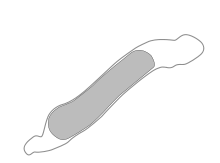Thermotoga maritima
| Thermotoga maritima | |
|---|---|
 | |
| Outline of a Thermotoga maritima section showing the "toga" | |
| Scientific classification | |
| Domain: | Bacteria |
| Phylum: | Thermotogae |
| Order: | Thermotogales |
| Family: | Thermotogaceae |
| Genus: | Thermotoga |
| Species: | T. maritima |
| Binomial name | |
| Thermotoga maritima Huber et al., 1986 | |
Thermotoga maritima is a hyperthermophilic organism that is a member of the order Thermotogales.
History
First discovered in the sediment of a marine geothermal area near Vulcano, Italy, Thermotoga maritima resides in hot springs as well as hydrothermal vents.[1] The ideal environment for the organism is a water temperature of 80 °C (176 °F), though it is capable of growing in waters of 55–90 °C (131–194 °F).[2] Thermotoga maritima is the only bacterium known to grow at this high a temperature; the only other organisms known to live in environments this extreme are members of the domain Archaea. The hyperthermophilic abilities of T. maritima, along with its deep lineage, suggests that it is potentially a very ancient organism.[3]
Physical attributes
T. maritima is a non-sporulating, rod shaped, gram-negative bacterium.[4] When viewed under a microscope, it can be seen to be encased in a sheath-like envelope which resembles a toga, hence the "toga" in its name.[4]
Metabolism
As an anaerobic fermentative chemoorganotrophic organism, T. maritima catabolizes sugars and polymers and produces carbon dioxide and hydrogen gas as by-products of fermentation.[4] T. maritima is also capable of metabolizing cellulose as well as xylan, yielding H2 that could potentially be utilized as an alternative energy source to fossil fuels.[5] Additionally, this species of bacteria is able to reduce Fe(III) to produce energy using anaerobic respiration. Various flavoproteins and iron-sulphur proteins have been identified as potential electron carriers for use during cellular respiration.[5] However, when growing with sulfur as the final electron acceptor, no ATP is produced. Instead, this process eliminates inhibitory H2 produced from fermentative growth.[5] Collectively, these attributes indicate that T. maritima has become resourceful and capable of metabolizing a host of substances in order to carry out its life processes.
Genomic composition
The genome of T. maritima consists of a single circular 1.8 megabase chromosome encoding for 1877 proteins.[6] Within its genome it has several heat and cold shock proteins that are most likely involved in metabolic regulation and response to environmental temperature changes.[5] It shares 24% of its genome with members of the Archaea; the highest percentage overlap of any bacteria.[7] This similarity suggests horizontal gene transfer between Archaea and ancestors of T. maritima and could help to explain why T. maritima is capable of surviving in such extreme temperatures and conditions.
Evolution
T. maritima contains homologues of several competence genes, suggesting that it has an inherent system of internalizing exogenous genetic material, possibly facilitating genetic exchange between this bacterium and free DNA.[5] Based on phylogenetic analysis of the small sub-unit of its ribosomal RNA, it has been recognized as having one of the deepest lineages of Bacteria. Furthermore, its lipids have a unique structure that differs from all other bacteria.[2]
References
- ↑ "Hyperthermophilic organism that shows extensive horizontal gene transfer from archaea". BioProject. National Center for Biotechnology Information. 2003. Retrieved January 14, 2012.
- 1 2 Robert Huber, Thomas A. Langworthy, Helmut König, Michael Thomm, Carl R. Woese, Uwe B. Sleytr & Karl O. Stetter (1986). "Thermotoga maritima sp. nov. represents a new genus of unique extremely thermophilic eubacteria growing up to 90°C". Archives of Microbiology. 144 (4): 324–333. doi:10.1007/BF00409880.
- ↑ Jenny M. Blamey & Michael W. W. Adams (1994). "Characterization of an ancestral type of pyruvate ferredoxin oxireductase from the hyerpthermophilic bacterium, Thermotoga maritima". Biochemistry. 33 (4): 1000–1007. doi:10.1021/bi00170a019.
- 1 2 3 "Geothermal organisms". Montana State University. Retrieved January 14, 2012.
- 1 2 3 4 5 Karen E. Nelson; Rebecca A. Clayton; Steven R. Gill; Michelle L. Gwinn; Robert J. Dodson; et al. (1999). "Evidence for lateral gene transfer between Archaea and Bacteria from genome sequence of Thermotoga maritima" (PDF). Nature. 399 (6734): 323–329. Bibcode:1999Natur.399..323N. doi:10.1038/20601. PMID 10360571.
- ↑ Latif, H; Lerman, J. A.; Portnoy, V. A.; Tarasova, Y; Nagarajan, H; Schrimpe-Rutledge, A. C.; Smith, R. D.; Adkins, J. N.; Lee, D. H.; Qiu, Y; Zengler, K (2013). "The genome organization of Thermotoga maritima reflects its lifestyle". PLoS Genetics. 9 (4): e1003485. doi:10.1371/journal.pgen.1003485. PMC 3636130
 . PMID 23637642.
. PMID 23637642. - ↑ Camilla L. Nesbo, Stéphane l'Haridon, Karl O. Stetter & W. Ford Doolittle (2001). "Phylogenetic analyses of two "archaeal" genes in Thermotoga maritima reveal multiple transfers between Archaea and Bacteria". Molecular Biology and Evolution. 18 (3): 362–375. doi:10.1093/oxfordjournals.molbev.a003812. PMID 11230537.
External links
- Thermotoga maritima genome
- Type strain of Thermotoga maritima at BacDive - the Bacterial Diversity Metadatabase